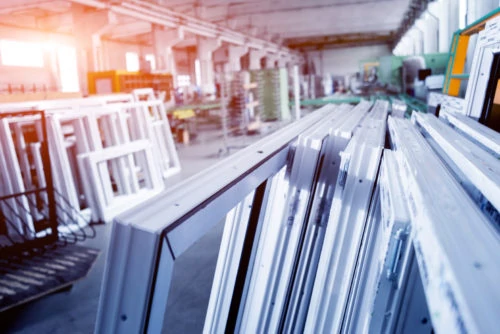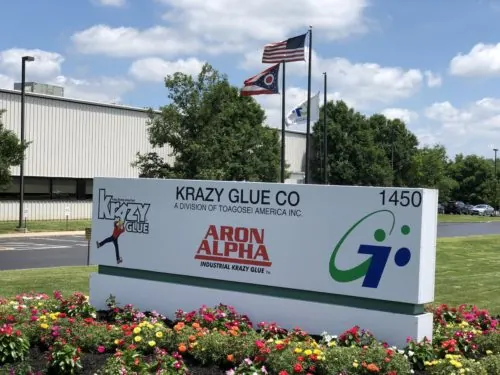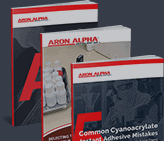Cyanoacrylates for Plastic Assembly Applications
What Are Cyanoacrylates?
Cyanoacrylates are one part, room temperature curing, fast-acting plastic bonding adhesives – they go by other names as well, such as instant glue, Krazy Glue, super glue, and CA glue. Cyanoacrylate chemicals can adhere to smooth plastic surfaces and bond similar and dissimilar plastic surfaces quickly for a strong, long-lasting bond. Not only are cyanoacrylates a popular choice for hobbyists, DIYers and consumer products, but they are also the ideal adhesive choice for bonding plastic assemblies and products in manufacturing.
Cyanoacrylate bonding agents work with an extensive variety of plastic compounds, and the process can be sped up through accelerators. Industrial-strength cyanoacrylates are a great alternative to ultrasonic welding, solvent welding and solvent cement and other adhering or fastening techniques.
How Are Cyanoacrylates Used in the Plastic Assembly Industry?
Cyanoacrylates are used during the plastic assembly process whenever similar or dissimilar plastic parts need to form a permanent, contact-based connection. With proper pretreatments, such as cleaning and abrading the surface, users can apply the bonding solution to one surface and join them together. Bonding times can depend on the materials involved, but the adhesion can be sped up with accelerators and exposing the chemicals to a weak base, such as water. Cyanoacrylates are available in one-part or two-part systems that form chemically resistant bonds.
Some of the typical applications for cyanoacrylates in the plastic assembly industry include:
- Parts made from these plastics: Rigid PVC, Acrylics (PMMA), ABS, polycarbonates, nylon, polyolefins
- 3D Prototype
- Primary and secondary processes for packaging cosmetics containers
- Automotive molding trim
- Plastic composite plantation shutters
- Vinyl window components

Industries that can utilize cyanoacrylates for streamlined, successful plastics assembly include:
- Aerospace
- Appliance
- Automotive
- Medical Device
- Electronic Assembly
- Machine Assembly
- Consumer Products
What Are the Benefits of Using Cyanoacrylates for Plastic Assembly?
Opting for cyanoacrylates in lieu of traditional adhesives or plastic welding techniques offers several advantages throughout the production process and for the end-use applications of the finished assembly, including:
- Bond Strength: Adhesive bonds created by instant glues are incredibly strong in regards to both shear strength and tensile strength. Not only does the direct bond contact between the two treated surfaces offer a strong bond, but also the chemicals are built to adhere to a wide range of plastic substrates. The hold is much stronger than epoxy and resin alternatives.
- Simplicity: Operators and automated systems can easily apply cyanoacrylates – the application process doesn’t involve a long series of steps or complex technologies. The chemicals are simple to dispense and activate: a thin coating along the substrate, and the presence of water (humidity in the air is typically adequate). The bond can cure rapidly in room temperature environments and be sped up through accelerators.
- Wide Variety: Cyanoacrylates come in many varieties with different viscosity (or thickness) levels, one- or two-part systems, and specialized material applications for different substrates. This allows users to choose the best adhesive given the substrates, potential gaps or imperfections in the bonding surfaces, and other unique factors.
Material Considerations for Cyanoacrylate Use on Different Plastics
Cyanoacrylates are able to provide their trademark adhesion and strength across different circumstances. For example, thicker instant glues can fill in the gaps between slightly mismatched substrate surfaces to provide a tight hold, whereas thinner adhesives can spread across the contacting surfaces quickly to provide a strong bond across more surface area.
Some considerations to keep in mind include:
- Dry Time: Cyanoacrylates have different dry times depending on the thickness, the exact materials at hand, and the humidity in the environment. If the dry time is too long, production speeds slow down. However, moving onto finishing and packaging stages too quickly can result in an imperfect bond. Manufacturers focusing on efficiency should consider adding chemical accelerators.
- Toxicity: The FDA and other industrial bodies regulate the use of chemicals or processes across industries. The use of different cyanoacrylates may be restricted for certain products. Cyanoacrylates are solvent free. Low odor grades are available.
- Stress Cracking: Stress cracking can affect the bond strength in plastic assemblies over time. We recommend removing excess adhesive as soon as possible from the following surface materials:
- Acrylics
- Cellulosics
- Polycarbonates
- Polystyrene
- Polyurethane
- Polyvinyl chloride (PVC)
- Difficult To Bond Engineering Plastics: Another benefit offered by cyanoacrylates is the ability to bond polyolefins and other difficult to bond plastics with surface treatment primers. The primer can significantly increase bonding performance of cyanoacrylate adhesives up to 20 times the unprimed surface.
Choose High-Performance Cyanoacrylates at Aron Alpha
At Aron Alpha, we specialize in creating high-performing cyanoacrylates that provide strong, fast-setting bonds across plastic substrates. For over 50 years, we’ve been a leading producer of instant adhesives, accelerators, and bonding solutions for industrial applications. We are ISO 9001:2015 certified and are committed to quality in every project. Contact our team today to find the right instant glue solution for your plastic assembly system needs.
For additional exploration, check out our resources below:







